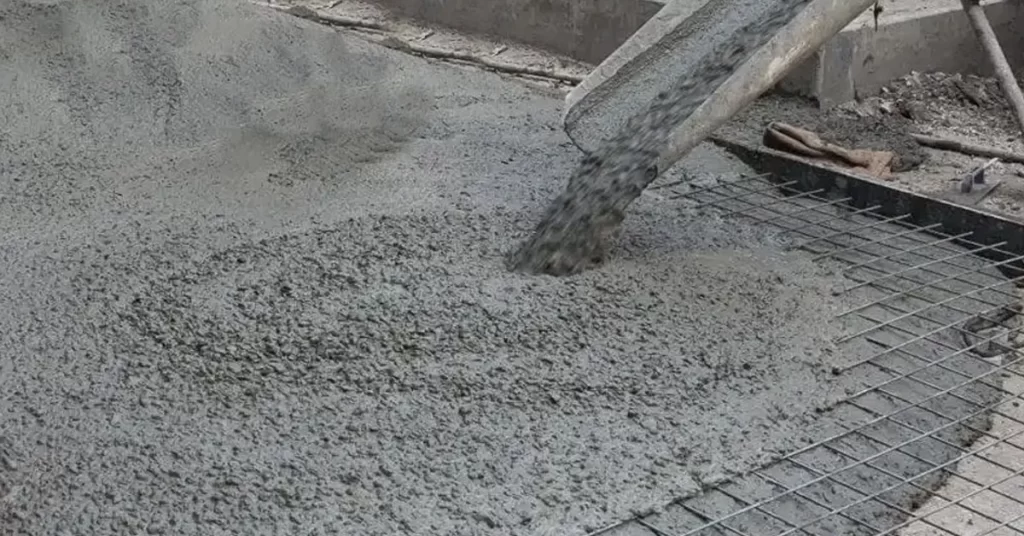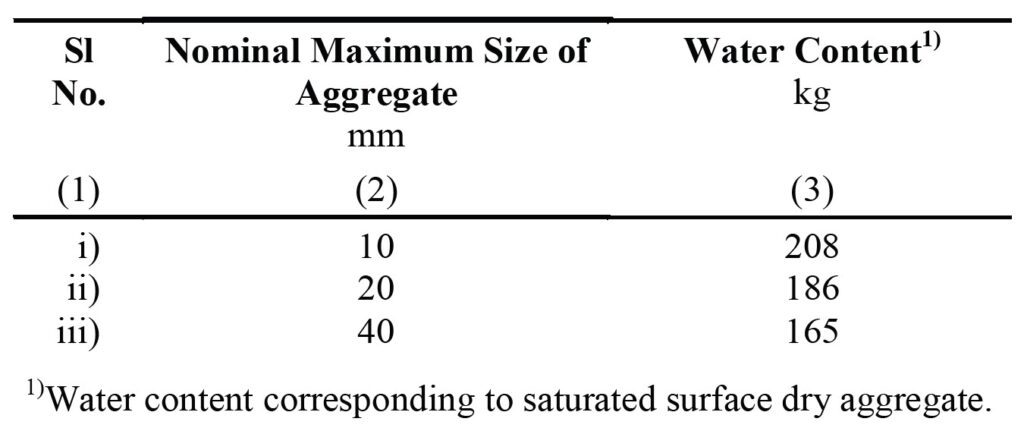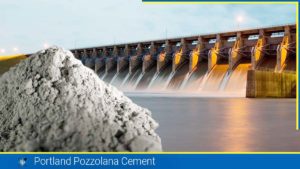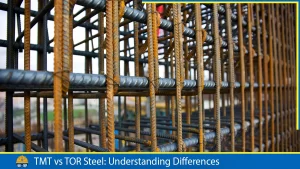The M30 concrete mix design is conducted in accordance with Indian Standard 10262: 2019 and Indian Standard 456: 2000. The mix design is carried out specifically with the required strength of the concrete and considering the environmental exposure conditions.
Performing Mix Design of M30 Concrete
The acceptance criteria for the concrete by IS 415: 2000 are as follows.

Data Required for Concrete Mix Design
- Stipulation For Mix Design
- Characteristic compressive strength at 28 days, fck— M30
- Type of cement— OPC 43 (Grade conforming IS 12269)
- Nominal maximum size of coarse aggregate— 20 mm
- Shape of coarse aggregate—angular
- Chemical admixture type— Super Plasticizer ECMAS HP 890
- Degree of workability required at the site— 50-75 mm (slump)
- Exposure condition of the structure — moderate
- Method of concrete placing— pump
- Degree of supervision— good
- Test data for preparing concrete from the laboratory
- Specific gravity of the material
- Cement — 3.16
- Fine aggregate — 2.72
- Coarse aggregate — 2.66
- Water absorption
- Coarse aggregates — 0.5%
- Fine aggregate — 2.0%
- Surface moisture
- Coarse aggregates — Nil
- Fine aggregate — 2.0%
- Sieve analysis
- Coarse aggregate conforming to all in aggregates of Table 2 of IS 383
- Fine aggregates conforming to Zone III of IS: 383—1970
Step 1: Determination of Target Strength
The target strength is determined using standard deviation \(S\) or factor based on the grade of concrete \(X\) and whichever is higher is adopted. As per IS 10262: 2019
- \(f_{target}\;=\;f_{ck}+1.65\times S\) or
- \(f_{target}\;=\;f_{ck}+X\)
Where,
\(f_{target}\) = target mean strength at 28 days
\(f_{ck}\) = target strength
\(S\) = standard deviation from Table 2 of IS 10262: 2019
\(X\) = factor based on the grade of concrete as per table 1 of IS 10262: 2019
⇒ 30 + 1.65 x 5.0 = 38.25 N/mm2
⇒ 30 + 6.5 = 36.5N/mm2
Therefore, the tergate strength is 38.25N/mm2 as it is higher than 36.5N/mm2
Also, read: Compressive Strength of Concrete
Step 2: Selection of Water-Cement Ratio:-
As the environmental exposure condition is moderate, as shown in Table 3 of IS 456: 2000, the water-cement ratio of 0.45 from Table 5 of IS 456 is considered.
In IS 10262, the curve between the free water-cement ratio and 28 days of compressive strength is given. As cement is OPC 43 and the target strength is 38.25 N/mm2 curve 2 is considered as shown in the figure below. Therefore, the water-cement ratio is 0.45 from the curve.
As admixture is used for preparing the concrete, the water-cement ratio should be reduced by 0.05.
W/C ratio = 0.45 – 0.05 = 0.4
Also, read: What is The Water-Cement Ratio?: Calculation and Value of Water Cement Ratio.
Curve 1: for expected 28 days compressive strength of 33 and < 43 N/mm2.
Curve 2: for expected 28 days compressive strength of 43 and < 53 N/mm2.
Curve 3: for expected 28 days compressive strength of 53 N/mm2 and above.
Notes From IS 10262-2019:
- In the absence of data on actual 28 days compressive strength of cement, the curves 1, 2 and 3 may be used for OPC 33, OPC 43 and OPC 53, respectively.
- While using PPC/PSC, the appropriate curve as per the actual strength may be utilized. In the absence of the actual 28 days compressive strength data, curve 2 may be utilized.
Step 3: Selection of Water Content
As per IS 10262 of Table 4, the water content per cubic metre of cement for nominal maximum size of aggregate 20mm is 186 kg. As per cl. 5.3. to achieve the desired workability (other than a 50 mm slump), adjust the water content by approximately 3 per cent for every 25 mm increase or decrease in a slump.
Estimated water content = 186+ (6% X 186) = 197 kg.
An admixture of Super Plasticizer can reduce the need for water content by 20 per cent as mentioned in IS 10262 for the concrete mix. Therefore water content is
⇒ (197-(20% X 197) = 157.6 kg water content.

Step 4: Calculation of Cement Content:
Using the water-cement ratio selected, calculate the cement content:
⇒\(Cement\;content=\frac{Water\;content}{Water-Cement\;Ratio}\)
⇒\(Cement\;content=\frac{\;157.6}{0.40}\) =394 kg/m3
For moderate exposure conditions, the minimum cement content for M30 grade concrete is 320 kg/m³, as specified in Table 5 of IS 456. Since the cement content of 394 kg/m³ exceeds this requirement (394 kg/m³ > 320 kg/m³), it is acceptable and thus adopted.
Step 5: Estimation of Coarse Aggregate Proportion:
The volume of coarse aggregate 20mm nominal size per unit volume of total aggregate for different zones of fine aggregate is 0.62 and the water-cement ratio is 0.5 as per Table 5 of IS 10262. As per cl. 5.5.1, “the proportion of the volume of coarse aggregates to that of total aggregates is increased at the rate of 0.01 for every decrease in water-cement/cementitious materials ratio by 0.05 and decreased at the rate of 0.01 for every increase in water-cement ratio by 0.05.”
⇒ 0.62 + 0.01 = 0.63 (for every 0.05 decrease ofw/c ratio, the increases 0.01 aggregate)
As per cl.5.5.2 of IS 10262, “it may be desirable to reduce the estimated coarse aggregate content determined using Table 5 up to 10 per cent” for pumpable concrete.
- The volume of coarse aggregate = 0.63 – (10% of 0.63) = 0.549
- The volume of fine aggregate = 1 – 0.549 = 0.451
Step 6: Estimation for Mix
Volume of concrete = 1 m3
- The volume of cement:
⇒\(V_{cement}=\frac{\;Mass\;of\;cement}{Specific\;gravity\;of\;cement}\;\times\frac1{1000}\)
⇒\(\frac{\;394}{3.16}\;\times\frac1{1000}\) = 0.125 m3 - The volume of water:
⇒\(V_{water}=\frac{\;Mass\;of\;water}{Specific\;gravity\;of\;water}\;\times\frac1{1000}\)
⇒\(\frac{\;157.6}{1}\;\times\frac1{1000}\) = 0.158 m3 - The volume of admixture:
⇒\(\frac{\;Mass\;of\;admixture}{Specific\;gravity\;of\;admixture}\;\times\frac1{1000}\)
Mass of admixture= \(\frac{1.1}{100}\times\frac{394}{\left(1.12\times1000\right)}\) = 0.00386 m3 , where specific gravity of admixture is 1.12 (assumed)
Also, read: Concrete Admixture: Types of Admixture
Proportion of Coarse and Fine Aggregate
- Total volume of aggregates:
⇒\(V_{total\;aggregate}=1-\left(V_{cement}+V_{water}+V_{admixture}\right)\)
⇒1 – (0.125+0.158+0.00386) = 0.713 m3
- The volume of coarse aggregate:
⇒\(V_{C.A}\)=0.63 – (10% of 0.63) = 0.549, as per cl.5.5.2 of IS 10262, for the pumpable concrete coarse aggregate can be reduced up to 10%. - The volume of fine aggregate:
⇒\(V_{F.A}\)=1 – 0.549 = 0.451
- Mass of coarse aggregate:
⇒\(V_{total\;aggregate}\times V_{coarse\;aggregate}\times specific\;gravity\;of\;coarse\;aggregate\;\times1000\)
⇒0.713 X 0.549 X 2.73 X 1000 = 1068 kg - Mass of fine aggregate
⇒\(V_{total\;aggregate}\times V_{fine\;aggregate}\times specific\;gravity\;of\;fine\;aggregate\;\times1000\)
⇒0.713 X 0.451 X 2.46 X 1000 = 791 kg
Recommended Mix Proportion Of Ingredients: M30:
From the Compressive Strength vs. c/w graph for target strength 31.6 MPa we get,
| Cement | Fine Aggregate | Coarse Aggregate | Water |
|---|---|---|---|
| 394 | 791 | 1068 | 157.6 |
| 1 | 2 | 2.71 | 0.4 |
Therefore, the mixed proportion of M30 grade of concrete is 1:2:2.7.
FAQs:
Q: What is the target strength for M30 concrete?
Answer: The target mean strength for M30 concrete is 38.25 MPa when calculated from the formula:
\(f_{target}=f_{ck}+1.65×S\)
where,
\(f_{ck}\) is the characteristic strength (30 MPa) and
\(S\) is the standard deviation (5 MPa for M30 if no test data is available).
Q: What is the water-cement ratio for M30 concrete?
Answer: According to IS 456:2000, the maximum water-cement ratio for M30 grade of concrete is 0.45. Typically, for durable concrete, a value between 0.42 and 0.45 is chosen, depending on specific requirements.
Q: How is the cement content calculated?
Answer: Cement content is calculated using the selected water content and water-cement ratio:
\(\text{Cement Content} = \frac{\text{Water Content}}{\text{Water-Cement Ratio}}\)
Q: What is meant by environmental exposure conditions in concrete mix design?
Answer: Environmental exposure conditions refer to the surrounding environmental factors that a concrete structure will be exposed to, such as moisture, chlorides, sulphate, freeze-thaw cycles, and extreme temperatures. These conditions can impact the durability of concrete and therefore must be considered during mix design.
Q: Can the mix design for M30 concrete be adjusted?
Answer: Yes, it can be adjusted based on site conditions, workability requirements, specific gravity of aggregates, and trial mixes to achieve the target strength and durability properties.
References:
- Duggal, S.K. (2008). Building material. New Age International (P) Ltd., Publishers
- Bureau of Indian Standard. (2019). Concrete Mix Proportioning— Guidelines. (IS 10262- 2019). Bureau of Indian Standards (BIS
- Bureau of Indian Standards. (2000). Plain and Reinforced Concrete: — Code of Practice (IS 456: 2000) (Fourth Revision). Bureau of Indian Standards (BIS).
![]()







